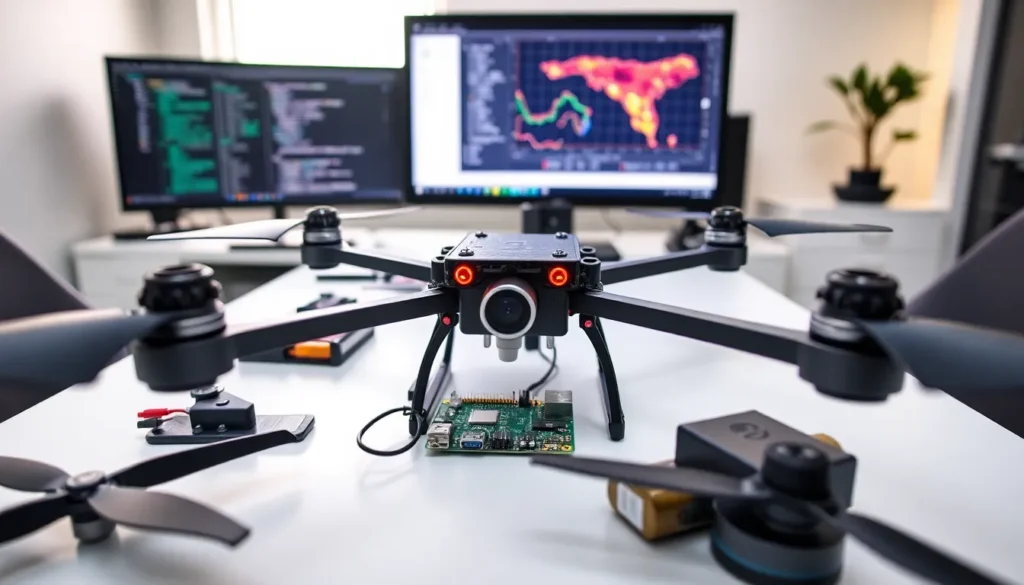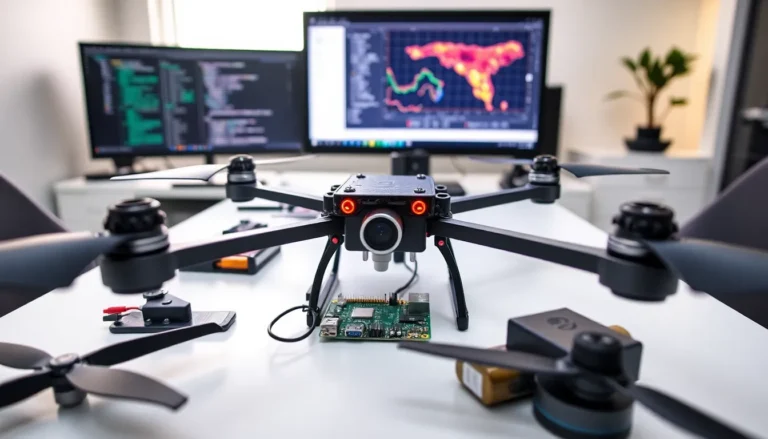Table of Contents
ToggleHave you ever wondered what the future of technology looks like? Picture this: a world where your coffee maker knows exactly how you like your brew, or where your doctor can consult with a supercomputer to diagnose your flu faster than you can say “data analysis.” Welcome to the age of computing innovations, where sci-fi is becoming reality faster than a speeding bullet. Let’s explore some of the most fascinating examples that are reshaping our lives, one byte at a time.
Artificial Intelligence and Machine Learning

Artificial Intelligence (AI) and Machine Learning (ML) are like the cool kids at the tech party. They’ve taken center stage, revolutionizing everything from healthcare to customer service. Imagine a world where algorithms can predict your preferences before you even know them. That’s what AI allows us to do. For instance, in healthcare, AI helps in diagnosing diseases with amazing accuracy by analyzing medical data faster than any human.
Machine Learning goes a step further. It uses tons of data to ‘learn’ and improve over time. Think of Netflix suggesting your next binge-watch based on your past viewing history. Throw in natural language processing, and you have voice-activated assistants like Siri and Alexa.
In a nutshell, AI and ML are shaping a future where machines are not just tools, but intelligent partners in problem-solving.
Blockchain Technology
Blockchain technology might sound like a buzzword, but it’s reshaping industries beyond just cryptocurrency. At its core, blockchain is a decentralized ledger that records transactions securely and transparently. Think of it as a digital notebook shared among numerous parties but secured in such a way that once something is written, it can’t be altered.
This innovation has massive implications for finance. With blockchain, the days of waiting for bank transfers are numbered. Imagine executing a transaction in seconds while maintaining perfect security. Companies like IBM are already implementing blockchain for supply chain transparency, ensuring that every stage of a product’s journey is visible.
From creating secure voting systems to enabling real estate transactions without intermediaries, blockchain tech is creating shifts that are as profound as they are beneficial.
Quantum Computing
Quantum computing is like regular computing’s brainy cousin that studied physics and decided to think outside the box. While traditional computers use bits (0s and 1s) to process information, quantum computers use quantum bits or qubits, which can exist in multiple states at once. This ability enables them to tackle complex problems exponentially faster than current computers.
For example, in drug discovery, quantum computers can analyze molecular interactions in ways traditional computers cannot. Companies like Google and IBM are racing to make quantum computing practical. If they succeed, they may unlock solutions to some of the world’s most challenging problems, from climate change modeling to optimizing logistics in global supply chains. In short, quantum computing might just be the magic wand we’ve needed all along.
Cloud Computing and Virtualization
Cloud computing has revolutionized how we access and store data. Instead of relying on physical servers or hard drives, users can now use online space to host applications, save documents, and run software. Services like AWS and Microsoft Azure have made it easy to scale resources up or down on demand, like a virtual buffet where you only pay for what you eat.
Virtualization, on the other hand, allows multiple operating systems to run on one physical machine. This efficiency means companies can dramatically reduce hardware costs while maximizing their capabilities. Both innovations are crucial for remote work, enabling teams to collaborate seamlessly, regardless of their geographical location. Which, let’s be honest, makes getting dressed for work much less taxing.
In a world increasingly reliant on remote access and real-time collaboration, cloud computing and virtualization are fast becoming necessities.
Internet of Things (IoT)
The Internet of Things, typically referred to as IoT, connects everyday objects to the internet, allowing them to collect and share data. Imagine your refrigerator notifying you when you’re low on milk or your thermostat adjusting the temperature based on your schedule. This technology is all about creating smarter homes and cities.
IoT applications span various realms, including agriculture, where farmers use sensors to monitor soil conditions and optimize water usage. In smart cities, IoT devices collect data for traffic management, improving public transport efficiency and reducing commute times.
These interconnected devices help streamline operations and enhance quality of life, all while reminding us that maybe we should start being friends with our appliances.
Augmented Reality and Virtual Reality
Augmented Reality (AR) and Virtual Reality (VR) are reshaping how we interact with the world. Think of AR as a way to superimpose digital information onto the real world. Ever used a filter on social media? That’s a pretty basic example of AR. It has incredible applications in training, education, and consumer experience.
VR, on the other hand, takes immersion to a whole new level. It transports users into entirely virtual environments for gaming, simulation training, and even therapy. Imagine training for medical procedures in a completely risk-free virtual setting.
With companies like Facebook investing heavily in this technology, the applications for AR and VR are quickly expanding. They hold the potential to not just alter entertainment but also revolutionize your everyday learning and working experiences.
5G Technology and Edge Computing
5G technology isn’t just another speed bump: it’s a paradigm shift in how we connect. With significantly higher speeds and lower latency, 5G networks enable seamless data exchange, even with the increasing number of connected devices.
Edge computing complements this by processing data closer to where it’s generated. This means faster response times for applications that require real-time data analysis, like in autonomous vehicles or smart industrial systems. In simpler terms, it’s about not making your devices travel to the cloud for everything, because who enjoys long waiting times?
Together, 5G and edge computing open up unprecedented possibilities for innovation, laying the groundwork for more robust and smarter technologies that can transform various sectors.







